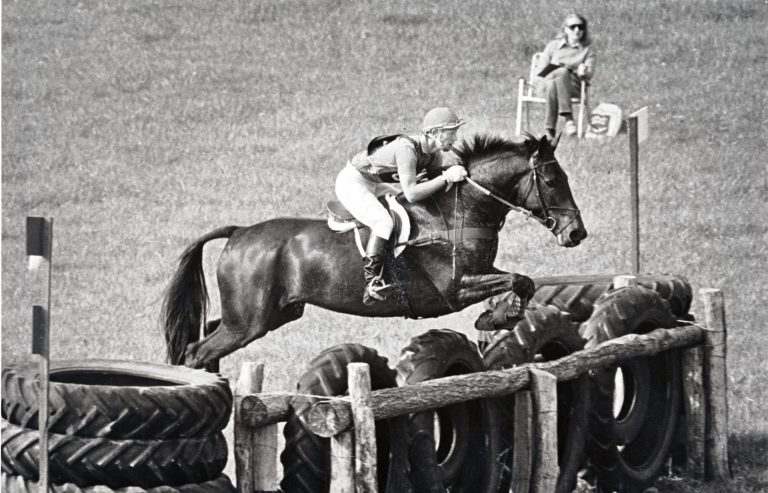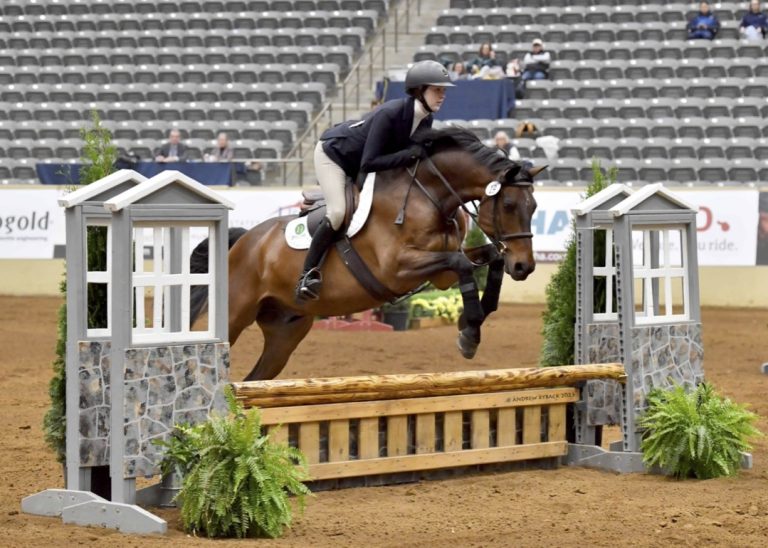Since 1990 I have watched the World Equestrian Games seven times, either as an administrator, coach, spectator or TV commentator. First held in Stockholm, Sweden, the WEG was originally designed to increase media presence and sponsorship opportunities by bringing the disciplines together at one venue for a single spectacular competition. (Prior to 1990, each international discipline held its own World Championship at a venue suitable for the sport.)
 Jumping down a huge drop so brilliantly takes complete confidence of both horse and rider and nerves of steel. Sandra Auffarth and Opgun Louvo show they have those qualities, which earned them team and individual gold medals at the 2014 WEG. | © Shannon Brinkman
Jumping down a huge drop so brilliantly takes complete confidence of both horse and rider and nerves of steel. Sandra Auffarth and Opgun Louvo show they have those qualities, which earned them team and individual gold medals at the 2014 WEG. | © Shannon BrinkmanThe WEG concept seems, however, to have become a victim of its own success. It has quickly outgrown the capabilities of most horse parks or other facilities to host such a vast undertaking in a manageable way. In addition to stadiums capable of seating a large crowd of spectators, organizers need ancillary services capable of quickly feeding literally thousands, sufficient lodging to house the ever-increasing number of people in attendance and a road system that can handle a large and sudden influx of traffic. (Traffic control was an obvious and frequently remarked problem at this year’s WEG in Normandy, France, August 23–September 7. There is nothing like a 10-mile traffic jam to give spectators a negative impression of their experience.) It was originally possible for one journalist to cover the entire series of competitions, but the addition of disciplines, the increasing distance between their venues and unreliable road networks have made this extremely difficult. The result is that the media must now go to the expense of sending extra journalists or decide not to cover some of the competitions. Either choice defeats the original purpose of the WEG.
Poor Footing Affects Results
In addition to the challenges of managing the WEG’s spectator component, there is the issue of meeting a wide array of horses’ needs. The eventing, driving and endurance disciplines all require large tracts of open land with suitable footing … a commodity that is increasingly in short supply everywhere. The eventing cross-country course at Haras du Pin National Stud this year illustrated the disproportionate effect that footing has on the results of the competition, on the television images that go out worldwide and, in fact, on the entire WEG concept.
The eventing competition itself was a question of the Germans followed by “whoever.” With three German team members in the top five after the dressage phase, it was obvious that the reigning Olympic champions would be hard to beat, especially given that the relative influence of the sport’s three phases in the scoring system is now 1.5:1.0:1.0 (meaning dressage is half again as important as cross country or show jumping.)
At the same time, all the riders and coaches agreed beforehand that the cross-country course at this year’s WEG would play a huge part in the results. The course itself, designed by Pierre Michelet, was what one would expect at from a 21stcentury World Championship: big, long and unrelentingly technical. The terrain was more undulating than we have seen for a decade, and the footing was deep and holding. This combination of factors made for some long faces the night before cross-country. Since the inception of the short format in 2004, a course that can exhaust a horse is the exception rather than the rule.
Team Completions a Struggle
It did not take long for the long faces to be justified: Buck Davidson, the first U.S. rider on course, ran into difficulties aboard Mr. and Mrs. Carl Segal’s Ballynoe Castle RM (Reg). Although riding conservatively to team orders, Buck could feel Reg becoming fatigued late in the course and wisely withdrew. The U.S. team supporters’ morale hit rock bottom when our second team rider, Phillip Dutton aboard Trading Aces LLC’s Trading Aces, also withdrew, thus eliminating the U.S. team. Only the top six WEG teams qualified for the 2016 Olympics in Rio de Janeiro, Brazil, so this blow to the U.S. Olympic qualification hopes increases the pressure on our riders to win at the 2015 Pan American Games, our only chance remaining to qualify for the next Olympics.
Disappointment was not confined to the U.S. contingent, as perennial eventing power New Zealand joined the States on the sidelines. Australia finished a team but had its own struggles, eventually finishing well behind France’s fourth-placed team. (However, as I write this, the team placing of France is in question because of a reported drug-test result of the best-placed French rider, Maxime Livio. If upheld, the result will lower France in the standings.)
At the conclusion of the cross country and with three solid scores in the bank, the German, British and Dutch teams were eagerly looking forward to the show jumping. Although the Dutch did not have the best of results, the difficulty of the cross country was such that just completing was enough to keep their team in contention—even though a couple of their riders could have been timed using an hourglass rather than a stop watch.
 The sight of spectators standing in mud for half an hour to buy an overpriced mystery-meat sandwich in Normandy explains my concern that the WEG concept has outgrown itself. Most people who attended were enthusiastic about the competitions, but traffic and primitive ancillary and sanitary facilities made their visit so unpleasant they would not go to another WEG as presently constituted. | © Nancy Jaffer
The sight of spectators standing in mud for half an hour to buy an overpriced mystery-meat sandwich in Normandy explains my concern that the WEG concept has outgrown itself. Most people who attended were enthusiastic about the competitions, but traffic and primitive ancillary and sanitary facilities made their visit so unpleasant they would not go to another WEG as presently constituted. | © Nancy Jaffer
A Thrilling Finish
The clumsiness of the WEG format took a hand again as the horses and riders remaining in the competition shipped more than an hour from the cross-country at Haras du Pin back to the main stadium in Caen for the final show-jumping phase. A sold-out venue awaited them, full of spectators who knew they were guaranteed a nail-biting finish. Riders jump in reverse order of placing, building the tension throughout the competition. By the time the medal contenders entered the ring, the crowd response veered from absolute quiet to groans of disappointment when an unlucky rail dropped or wild jubilation when a rider finished successfully. To add to the excitement, five riders were within four points (one rail) of each other. A clear round might move them from fifth to first, but one mistake meant they could spend the rest of their lives wondering “if only.”
With three riders left to compete for the individual medals, Germany’s Michael Jung entered the arena on his parents’ Fischerrocana FST just 2.3 points behind the overnight leader, Great Britain’s William Fox-Pitt. Michael turned in yet another of his flawless performances, which we might expect from the only event rider to ever hold the Olympic, World Champion, and European Champion titles at the same time. To add even more drama to the moment, Michael’s 9-year-old mare was his third-string mount—basically, it looks like this young man is a threat to beat you with anything in his barn.
However, the pressure did not affect his teammate Sandra Auffarth; entering the arena in second, she never looked like touching a rail with Opgun Louvo, thus finishing no worse than the silver medal and still with a chance at the gold. It was all up to William Fox-Pitt, who entered the arena with a 1.3-point margin on Christopher Stone’s lovely stallion Chilli Morning. But an early rail dropped William to the bronze-medal position while the two German riders added individual gold and silver to go with their team gold. You all know the end of the story by now: Once again, the German team took home three of the four eventing medals available, just as they did at both the 2012 London Olympics and the 2013 European Championships. With results like this, Germany must be the overwhelming favorite for the 2016 Olympics.
What About 2018?
My thoughts, however, remain with the implications of any WEG organizers’ increasing difficulty in accommodating all disciplines so that horses are able to do their best … and enthusiastic spectators are able to see them performing. The footing at the venue is especially critical. Tired horses and tired riders make unfortunate mistakes, which makes for ugly images and does not present eventing in a positive light.
This is particularly cause for concern as the 2018 WEG is scheduled to return to Bromont, in Quebec, Canada. Bromont was the site of the 1976 Olympics when the footing on the local golf course used for cross-country was questionable. It is certain that the road system around Bromont is inadequate, and hotel beds will be in very short—and very expensive— supply. The FEI (International Equestrian Federation) has difficulty learning from experience, so at this point, success in 2018 does not look like a predetermined result. Based on spectators’ experiences in Normandy, serious questions are already being asked about the suitability of Bromont for a global effort of this nature. Hopefully the Bromont organizing committee will draw the correct conclusions from this year’s WEG, and put on an event that matches or surpasses the triumphs of Aachen, Germany, in 2006, and Lexington, Kentucky, in 2010.
In closing, I was personally thrilled at the inclusion of Lynn Symanski and Kim Severson on the U.S. team this year. This marks the 36th year in a row that myself or one of my students has been on an Olympic or World Championship team. I expect that current U.S. eventing coach David O’Connor will surpass that record … but it will take him until 2052 to do it! I doubt I will still be around to see it, but I am sure that I will soon see our eventing team return to the top level of the podium.
This article originally appeared in the November 2014 issue of Practical Horseman.










